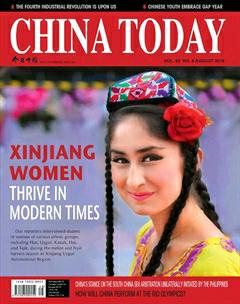Economy
No RMB Devaluation to Stimulate Foreign Trade
China has no intention of devaluing the RMB to gain an advantage in global trade, and there is no basis for its long-term depreciation, the Peoples Bank of China (PBOC) said at the end of June, according to a report by Xinhua News Agency.
The RMB, or yuan, has generally re- mained stable despite global volatility since Britain voted to leave the European Union, the central bank said in a statement.
The banks remarks were in response to media reports forecasting substantial drops in the RMB exchange rate by the end of the year. “The reports misled expectations and disrupted the market, encouraging speculative selling. We strongly condemn this behavior, which is irresponsible and against professional ethics,” the PBOC said.
Chinas currency will remain stable, and at a reasonable level thanks to the countrys sound economic fundamentals, the statement said. The Chinese economy will maintain steady growth and continue to see a balance of payments surplus, with abundant foreign exchange reserves, sound financial conditions and a stable monetary system, the PBOC said.
China will propel forex reform and continue to allow the market play a decisive role in exchange rate, the bank added.
Green Finance Surges in 2015
At the end of 2015, Chinese banking institutions recorded a green credit balance of RMB 8.08 trillion (US $1.22 trillion), RMB 7.01 trillion of which is attributable to 21 major banks – a 16.42 percent rise since the beginning of the year, according to a report released by the China Banking Association at the end of June.
It is estimated that the projects these loans financed saved last year about 221 million tonnes of standard coal, and 756 million tonnes of water; they also reduced carbon dioxide emissions by 550 million tonnes and sulfur dioxide emissions by 4.85 million tonnes, the report said.
While offering strong credit support for growth of the green economy, Chinese banks have strictly controlled loans to highly pollutant industries or those operating at overcapacity or consuming excessive energy, according to the report. Certain banks have not issued loans to such industries for two consecutive years.
Along with the transformation of the economic growth model, green industry development has generated a great demand for financial services. Chinese banks and financial institutions are encouraged to channel more investment into energy-saving and environmentally friendly projects through financial products and services such as loans, bonds, stocks, private equity, insurance and carbon emissions trading.
MOC: Belt and Road Initiative Yields Stage Achievements
Chinas Belt and Road construction projects are gaining steam and have yielded various achievements, Assistant Minister of the Ministry of Commerce (MOC) Tong Daochi said at a recent press conference.
Economic cooperation between China and Eurasian countries has generated rapid development, the fruits of which include the agreement with Russia on aligning the construction of the Silk Road Economic Belt with the development of the Eurasian Economic Union(EAEU), and joint development strategies with the European Union, Kazakhstan, Mongolia and Indonesia, Tong said.
Statistics show that direct investment by Chinese enterprises in countries along the Belt and Road in 2015 amounted to US $14.8 billion, up 18.2 percent year on year, and that the 2015 contract value with these countries rose 7.4 percent to US $92.6 billion. A large number of projects, such as the Hungary-Serbia Railway and China-Kazakhstan logistics terminal in Lianyungang City, have been completed, or are under construction.
China will continue to advance construction projects along economic corridors including the China-Mongolia-Russia economic corridor, the new Eurasia land bridge economic corridor, and the Bangladesh-China-India-Myanmar economic corridor, to facilitate international logistics, Tong said.
The 5th China-Eurasia Expo is set to kick off in Urumqi, capital of Xinjiang Uygur Autonomous Region, in September. Participating officials, business leaders from home and abroad, and heads of international organizations will attend various events in order to exchange ideas and seek business cooperation.
Since its establishment in 2011, the China-Eurasia Expo has witnessed the signing of agreements worth a total of RMB 900 billion, according to Shi Dagang, vice chairman of Xinjiang Uygur Autonomous Region.
JD.com Partners with Walmart
JD.com, Chinas second largest e-commerce platform, announced at the end of June that it will partner with global retail giant Walmart in a strategic cooperation arrangement.
Under the deal, JD will take over Walmarts ownership of the Yihaodian brand, website, and app, in exchange for which it will issue Walmart 145 million shares, or a five percent equity stake in JD.com worth about US $1.5 billion, according to the current valuation. Walmart bought Yihaodian, which sells food and beverages, home goods and electronics, last year as its China online unit. As Yihaodian has a strong presence in both eastern and southern China, the deal offers JD a great opportunity to strengthen its market share in eastern China.
The transaction is expected to give Walmart access to JDs online traffic and bolster its presence in the extraordinarily lucrative, albeit increasingly competitive, online marketplace.
Walmart Sam Club China will open a flagship store on JD.com, and Walmart stores will forge a partnership with JD Daojia, JDs online-to-offline that offers consumers two-hour deliveries of products from local supermarkets, and Dada, a crowdsourcing platform, and so attract online shoppers to its chain stores.
Partnering with Walmart is a big step towards JDs going global. Both companies will leverage their supply chains and broaden the range of imported goods in an endeavor to meet the growing demands of Chinas increasingly affluent and quality-oriented consumers.
JD has almost 6,000 delivery and pickup stations across China, along with a huge customer base and an efficient same-day delivery network.

